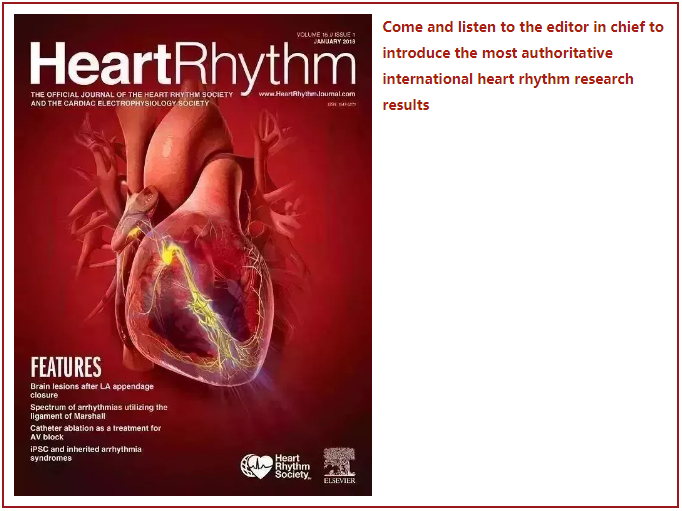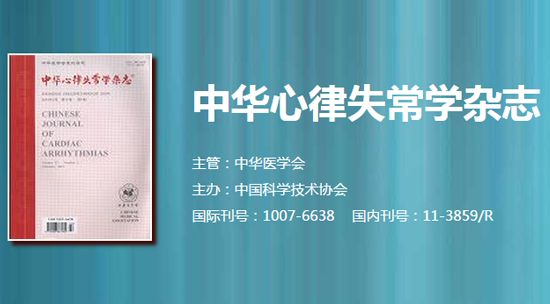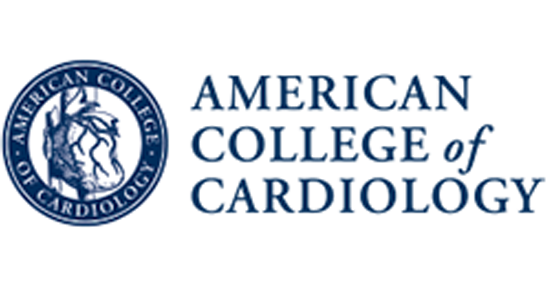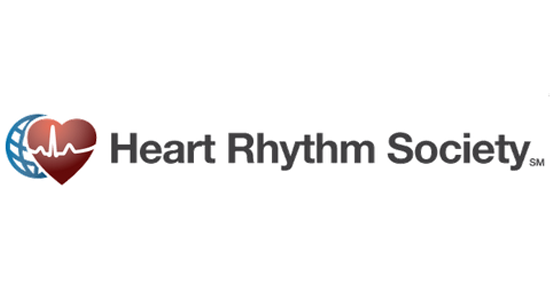HeartRhythm主编—陈鹏生教授语音速递(四月刊 英文版)


Peng-Sheng Chen
Hello, this is Dr. Peng-Sheng Chen, the Editor-in-Chief of Heart Rhythm. I am summarizing the April 2022 issue of the journal.
The first article is “Ectopy-Triggering Ganglionated Plexus Ablation to Prevent Atrial Fibrillation: GANGLIA-AF Study”. The study was to test the hypothesis that ablating the ectopy-triggering GPs (ET-GPs) prevents AF. A total of 102 randomized patients were analyzed on a per-protocol basis after GP ablation or PVI. Ectopy triggering GP ablation without AV dissociating GP ablation achieved 58% (22 of 38) freedom from the primary end point. There was a significantly higher reduction in antiarrhythmic drug usage postablation after GP ablation than after PVI. The authors conclude that GP ablation did not prevent atrial arrhythmias more than PVI. However, less radiofrequency ablation was delivered to achieve a higher reduction in antiarrhythmic drug usage with GP ablation than with PVI.
Next up is “Empiric Ablation of Polymorphic Ventricular Tachycardia/Fibrillation in the Absence of a Mappable Trigger”. The purpose of this study was to report the feasibility and efficacy of a novel empiric ablation strategy of pacemapping to stored ICD template electrograms (SITE) of the clinical PVC trigger. Regions within the left Purkinje network yielded the best pacemap match for the SITE of the clinical PVC trigger in 55% of ablation targets, followed by the RV moderator band region in 14%. Freedom from ICD therapies off antiarrhythmic drug was 64% at 6 months and 48% at 12 months. The authors conclude that in the absence of a mappable trigger, an empiric strategy of interrogating the Purkinje network, papillary muscles, and outflow tract regions by pacemap matching with SITE of the clinical PVC is feasible to guide ablation. A significant reduction in VF/PMVT therapy burden and antiarrhythmic drug utilization was observed after a single procedure.
That paper is followed by “Isolated Critical Epicardial Arrhythmogenic Substrate Abnormalities in Patients with Arrhythmogenic Right Ventricular Cardiomyopathy and Ventricular Tachycardia”. The authors studied 71 consecutive patients with VT who met Task Force criteria for ARVC and underwent detailed ENDO and EPI mapping. Twelve patients (17%) had isolated epicardial substrate. Extensive EPI bipolar low-voltage area and EGM abnormalities were identified in all patients. A median of 2 VTs were induced and localized to the isolated epicardial substrate. During follow-up of 56 months, 9 of 12 patients (75%) remained VT-free. In conclusion, substrate abnormalities can uncommonly be isolated to the RV EPI in patients with ARVC and VT. EPI ablation eliminates VT in these patients and typically results in long-term VT-free survival.
Next up is “High Resolution Parahisian Mapping and Ablation Using Micro-electrode Embedded Ablation Catheters.” The purpose of this multicenter prospective study was to test the hypothesis that microelectrode-embedded catheters more accurately define the near-field compact AV node compared to conventional catheters. Detailed AV junction maps were created in 47 patients using a microelectrode -embedded catheter. Ablation at microelectrode determined His electrogram resulted in AV block after limited ablation in all patients. In the clinical phase, a microelectrode His-avoidance strategy could avoid AV block in a prospective registry of 11 patients. In conclusion, the microelectrode-embedded catheter more accurately defines the region of the compact node, and ablation in this region is associated with a high risk for AV block. microelectrode-embedded-based mapping has the potential to significantly enhance ablation safety and efficacy.
The next article is “Cardiac Deceleration Capacity as an Indicator for Cardioneuroablation in Patients with Refractory Vasovagal Syncope”. The objective is to investigate the prognostic value of baseline deceleration capacity in patients with refractory vasovagal syncope after cardioneuroablation. This study enrolled 123 patients with the diagnosis of vasovagal syncope. All patients underwent cardioneuroablation that was performed in the left atrium. After a mean follow-up of 4.0 years, 33 patients experienced syncope/presyncope events (26.8%). Patients with recurrent syncope/presyncope have a lower baseline deceleration capacity level than do those without. Each 1-ms increase in deceleration capacity had a 34% reduced risk of syncope/presyncope recurrence after cardioneuroablation. Nighttime deceleration capacity had the highest discrimination value. The authors found that baseline nighttime deceleration capacity≥ 10 ms may act as an indication for cardioneuroablation in patients with refractory vasovagal syncope.
Up next is “Evaluation of EHRA Consensus in Patients with Cardiovascular Implantable Electronic Devices and Staphylococcus aureus Bacteremia”. The purpose of this study was to examine the rate and clinical characteristics of Staphylococcus aureus Bacteremia (SAB) in patients living with CIED using the 2019 European Heart Rhythm Association (EHRA) international consensus document. Overall, 110 patients with CIED developed SAB. Fifty-seven (51.8%) and 31 (28.2%) patients met criteria for definite and possible CIED infections, respectively. The authors found that CIED extraction was associated with an 83% reduction in risk of 1-year mortality in the definite CIED infection group. In conclusion, the rate of CIED infections after SAB was higher than that reported previously. Increased use of TEE and a novel case definition with broader diagnostic criteria likely were operative, in part, in accounting for the higher rate of CIED infections complicating SAB. Complete device removal is critical in patients with definite CIED infection to improve 1-year mortality.
Coming up is “QT Prolongation in Patients with Index Evaluation for Seizure or Epilepsy is Predictive of All-cause Mortality”. The authors performed a retrospective cohort study including all patients seen at Mayo Clinic with index evaluation for seizure or epilepsy. An ECG was obtained in 18,222 patients (57.4%). After patients with confounding ECG findings were excluded, primary prolonged QT intervals were seen in 223 cases (1.4%), similar to the general population. Kaplan-Meier analysis demonstrated a significant increase in mortality (Cox hazard ratio 1.90) for prolonged optimal cutoff QT. The authors conclude that a prolonged optimal cutoff QTc interval predicts all-cause mortality in patients evaluated for seizure and those diagnosed with epilepsy. The authors advocate the routine use of a 12-lead ECG at index evaluation in patients with seizure or epilepsy.
The next article is “Relationship between Life-threatening Events and Electromechanical Window in Patients with Hypertrophic Cardiomyopathy”. The authors enrolled 458 patients with mean age 52.4 years). The electromechanical window (EMW) is defined as the interval between the Q wave and aortic valve closure minus the QT interval. The EMW was more negative in patients with HCM than in normal controls. Life-threatening events occurred in 25 patients (5.5%). EMW was more negative in patients with life-threatening events than in those without. The cutoff value of EMW to identify patients with life-threatening events was -54 ms. EMW less than -54 ms, unexplained syncope, pediatric onset, and extreme left ventricular hypertrophy were significant risk factors for life-threatening events on multivariate analysis. In conclusion, EMW was more negative in patients with HCM than in healthy individuals, and profound EMW negativity was an independent risk factor for life-threatening events. EMW can be useful for risk stratification of sudden cardiac death in patients with HCM.
The next one is “The Importance of Early Evaluation after Cardiac Resynchronization Therapy to Redefine Response: Pooled Individual Patient Analysis from Five Prospective Studies”. Individual patient data from 5 prospective CRT studies were pooled. Classification of CRT response status using clinical composite score and LV end-systolic volume index were made at 6 months. Among a total of 1603 patients, mortality was significantly lower for patients in the improved and stabilized groups than in the worsened group for both measures after adjusting for potential confounders. The authors conclude that patients with a worsened CRT response status have a high mortality rate and HF-related hospitalizations. Stabilized patients have a more favorable prognosis than do worsened patients and thus should not be considered CRT nonresponders.
The following article is “Lower Body Muscle Preactivation and Tensing Mitigate Symptoms of Initial Orthostatic Hypotension in Young Females”. Initial orthostatic hypotension (IOH) is a form of orthostatic intolerance defined by a transient decrease in blood pressure upon standing.The purpose of this study was to provide IOH patients with effective symptom management techniques. Study participants completed 3 sit-to-stand maneuvers, including a stand with no intervention (Control), lower body pre-activation (PREACT), and lower body muscle tensing (TENSE). A total of 24 female IOH participants completed the study. The drops in mean arterial pressure following PREACT and TENSE were significantly reduced compared to Control. The authors conclude that both the drop in mean arterial pressure and symptoms upon standing improved with either PREACT or TENSE. These maneuvers provide novel symptom management techniques for patients with IOH.
Next up is “Dysautonomia Following COVID-19 Is Not Associated with Subjective Limitations or Symptoms but Is Associated with Objective Functional Limitations”.The authors studied patients referred to post–COVID-19 service and found 51 of the 205 patients (25%) reviewed as part of this service evaluation had dysautonomia. There were no associations between symptoms or perceived functional limitation and dysautonomia. Patients with dysautonomia demonstrated objective functional limitations with significantly reduced work rate and peak oxygen consumption and a steeper (less efficient) V̇e/V̇co2 slope. The authors conclude that dysautonomia is associated with objective functional limitations but is not associated with subjective symptoms or limitation.
The next article is “Women in Procedural Leadership Roles in Cardiology: The WILL (Women In Local Leadership) Observational Study”. Although 50% of U.S. medical students are women, this percentage fails to translate to cardiology. The authors collected data on WATCHMAN implanters and hospitals from January 2017 to December 2018. Men comprised 97% of implanters (860/886). EP made up 61% of implanters. Women represented <1% of Directors of interventional cardiology and only 2.6% of both Directors of EP and Chiefs of Cardiology. Hospitals with a woman in leadership had a 4 times greater odds of a woman implanter. The authors conclude that women are underrepresented in cardiology procedural subspecialties in the use of novel technology and in key leadership roles. There was a greater odds of women early implanters of WATCHMAN if a woman led locally. Increasing women in leadership may improve gender diversity through visibility of role models.
Up next is “Association between Nocturnal Heart Rate Variability and Incident Cardiovascular Disease Events: The HypnoLaus Population-based Study”. A total of 1784 participants from the HypnoLaus population-based cohort free of cardiovascular disease at baseline were included. Among them, 67 participants (3.8%) developed cardiovascular disease over mean follow-up of 4.1 ± 1.1 years. In a fully adjusted model, acceleration capacity, deceleration capacity and heart rate fragmentation were the only HRV metrics significantly associated with incident cardiovascular disease events after controlling for false discovery rate. The authors conclude that nocturnal novel HRV parameters are better predictors of cardiovascular disease events than time and frequency traditional HRV parameters.
Up next is “Incidence of Life-threatening Events in Children with Wolff-Parkinson-White Syndrome: Analysis of A Large Claims Database”. A retrospective cohort study was conducted using claims data. The authors found that the prevalence of WPW syndrome was 0.03% (8733/26 million) over a median follow-up of 1.6 years. A life-threatening event occurred in 49 subjects (0.7%), including VF in 20 (0.3%). The incidence of VF was 0.8 events per 1000 person-years. There were no occurrences of VF in controls. The rate of life-threatening event was 70 times higher in subjects with WPW syndrome than in controls. The observed range of 0.8-1.9 events per 1000 person-years is consistent with prior reports from selected populations. A comparison of event rates to matched controls confirms and quantifies the significant elevation in VF and life-threatening event risk in pediatric WPW syndrome.
The next paper is “Catheter Ablation in Adult Congenital Heart Disease on Uninterrupted Oral Anticoagulation: Is It Safe? Data from a Large Single-center Study”. Retrospective analysis of 234 ACHD patients undergoing 368 ablation procedures on uninterrupted oral anticoagulation was undertaken. No thromboembolic complications occurred. Major complications occurred in 4 patients (1.1%). The authors conclude that catheter ablation in ACHD patients on uninterrupted oral anticoagulation is feasible and safe. No thromboembolic events occurred, and major bleeding or vascular access complications were rare. No significant differences regarding minor bleeding or vascular access complications between patients on DOAC or vitamin K antagonists were found.
The following article is “Cardiac Resynchronization Therapy in Congenital Heart Disease Patients with Systemic Right Ventricle”. The authors aimed to analyze outcomes of patients with systemic right ventricle implanted with a CRT device. A total of 85 patients with congenital heart disease (CHD) were enrolled, including 31 patients with systemic right ventricle. The proportion of CRT responders at 6, 12, and 24 months were 82.6%, 80.0%, and 77.8% in patients with systemic right ventricle, which was not significantly different than 66.7%, 64.3%, and 69.6%, respectively, in patients with systemic left ventricle. In this multicenter cohort, one-third of patients with CHD implanted with a CRT device had systemic right ventricle. CRT in patients with systemic right ventricle was associated with a high rate of responders, comparable to that of patients with systemic left ventricle.
Next up is “Developmental Changes in Cardiac Expression of KCNQ1 and SCN5A Spliceoforms Implications for Sudden Unexpected Infant Death”. The authors quantified expression of SCN5A and KCNQ1 spliceoforms in 153 human cardiac tissue samples from decedents that died of sudden unexpected infant death and other known causes of death. There is a stepwise increase in the adult/fetal SCN5A spliceoform ratio from <2 months through infancy and into adulthood. For KCNQ1, there is a decrease in the ratio of KCNQ1b to KCNQ1a between the <2-month and the 2- to 4-month age groups. The authors conclude that this study documents the developmental changes in SCN5A and KCNQ1 spliceoforms in humans. These data suggest that spliceoform expression ratios change significantly throughout the first year of life.
The last paper is “Use of Machine Learning to Classify High Risk Variants of Uncertain Significance in Lamin A/C Cardiac Disease”. Genetic sequencing was performed on family members with conduction system disease, and patient cell lines were examined for LMNA expression. The authors discovered a novel LMNA variant segregating with conduction system disease in a multigeneration pedigree, which was reported as a VUS by a commercial testing company. Additional familial analysis and in vitro testing found it to be pathogenic, which prompted the development of a machine learning algorithm that used in silico predictions of pathogenicity for known LMNA missense variants. This identified 3 clusters of variation, each with a significantly different incidence of known pathogenic variants. The authors conclude that an unsupervised machine learning method successfully identified clusters enriched for pathogenic LMNA variants including a novel variant associated with conduction system disease. Our machine learning method may assist in identifying high-risk VUS when familial testing is unavailable.
I hope you enjoyed this podcast. For Heart Rhythm, I’m the Editor-In-Chief, Dr. Peng-Sheng Chen.











